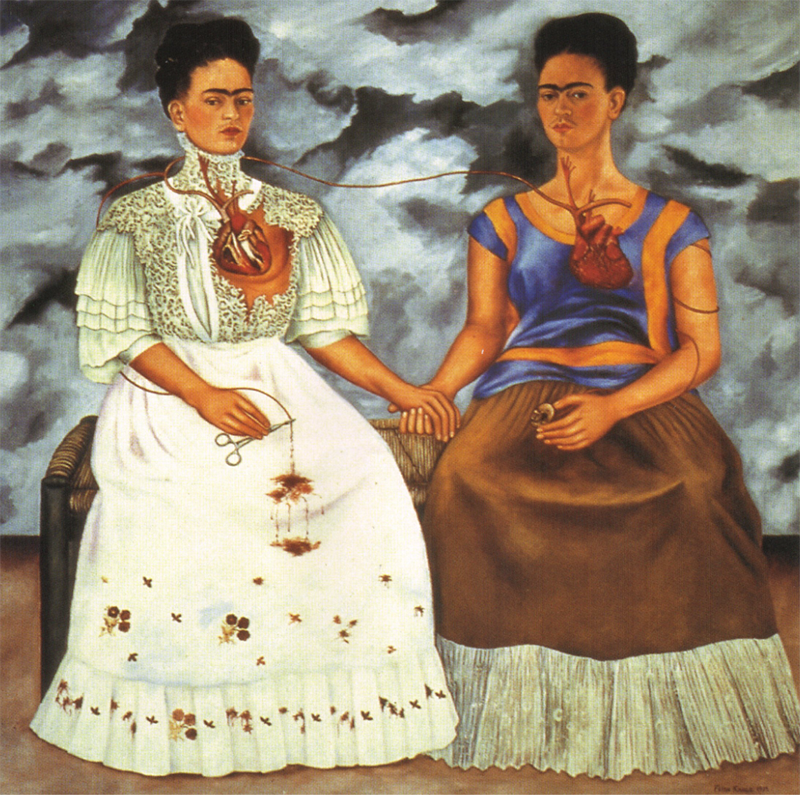
Frida Kahlo was a famous 20th-century painter from Mexico. Khalo established herself as the creator and muse behind several outstanding artworks during her career. Her Mexican heritage mainly inspired Kahlo’s artistry. In addition, she immersed herself in her native culture and spirituality in her daily life, which is often reflected in her art.
In addition to her extraordinary art, Kahlo is also known for her activism, often using paintings like her 1933 masterpiece—My Dress Hangs There—as commentary. She tackled social issues like sexual identity and gender inequality. She was also heavily involved in Mexican nationalism and communist politics. Her activism boosted her reputation posthumously as she is viewed as a symbol of feminist and sexual rights.
Kahlo painted several subjects, including familiar and spiritual scenes, but her most notable works carry autobiographical elements. She is most famous for her self-portraits, producing several mesmerizing images of herself. Although her style of portraiture evolved over the years, certain features like her famous unibrow and stoic stare remained.
Beginning of Frida Kahlo’s Artistic Career
Born Magdalena Carmen Frieda Kahlo y Calderón on July 6, 1907, in Coyoacán, Mexico, Kahlo was the 3rd of 4 daughters born to German Photographer Wilhelm (also called Guillermo) and his Mexican wife, Matilde.
As a teenager was politically active, befriending other like-minded youth at school and joining the Young Communist League and the Mexican Communist Party. In 1925, Frieda was on a bus with a school friend when she suffered a terrible accident; their bus collided with another vehicle, severely injuring Kahlo. The injuries left her bedridden with lifelong medical complications.
While recovering from her injuries, Kahlo taught herself how to paint, and her parents encouraged her by attaching an adjustable easel to her recovery bed. When she was fully recovered, Kahlo joined the Mexican Communist Party, where she was reacquainted with Diego Rivera, a muralist who appreciated Kahlo’s paintings and encouraged her to continue painting.
The pair got married in 1929, and the union heavily influenced Kahlo’s lifestyle and art. She began wearing her signature Tehuana dress and painting in the Mexican folk art style. Here are some of the most famous drawings by Frida Kahlo.
Self-portrait With A Necklace And A Hummingbird
Also called Autorretrato con Collar de Espinas in Spanish, this 1940 painting by Kahlo is perhaps her most famous self-portrait. It was produced shortly after the completion of her first marriage to Rivera.
The painting depicts Kahlo with her signature facial features and expressions and some black animal companions; a monkey, a cat, and a hummingbird. The bird appears like a pendant while the cat and monkey are perched on her shoulders. A necklace made of thorns sits tightly around her neck, drawing tiny drops of blood. Behind her is a simple background of green foliage and a blue sky.
Her ex-lover and photographer Nickolas Muray bought it, and it is currently part of the Nickolas Muray collection at the Harry Ransom Center, University of Texas.
The Two Fridas
This 1939 oil painting is a double self-portrait of the artist. It depicts two versions of Kahlo seated side by side and holding hands. They are similar in every way except their outfits; the Frida on the left is illustrated in a white Victorian dress, while the Frida on the left is dressed in traditional Mexican attire.
Some suggest that the two figures in the portrait symbolize Frida’s dual heritage—a German father and a Mexican mother—while others argue that the figures represent her choice of style before and during her marriage to Rivera. According to Kahlo herself, the image was inspired by the memory of a childhood imaginary friend.
The painting remains one of her most notable paintings to date. It stayed in her possession until her passing but resided at the Museo de Arte Moderno in Mexico City.
The Broken Column
This 1944 oil painting by Kahlo was produced shortly after her spinal surgery. The surgery corrected some complications resulting from an accident she suffered as a teenager.
The painting depicts a harrowing image that communicates pain and suffering. She paints herself on a barren landscape in the middle of an earthquake. Like the landscape, her nude body is held together by a metal corset. Her torso is cracked open to reveal a shattered ionic column in place of her spinal cord. The artist also paints nails all over her face and body as tears flow down her cheeks.
The painting is perhaps Kahlo’s most macabre image. It undeniably communicates her painful perception of her own body owing to her medical complications. The portrait portrays pain in its raw form while also giving insight into her struggles. It is currently housed at the Museo Dolores Olmedo in Mexico City.
Self-portrait With A Small Monkey
This artwork by Frida Kahlo was created in 1945 with subtle additions of political and religious elements. The painting was primarily inspired by Mexican culture and folk art style, reflecting her patriotism to her country.
The image depicts a yellow ribbon connecting all the elements of the painting, including Kahlo herself. Also in the painting are her pets—a spider monkey and a hairless dog—and a native Mexican idol.
It is said that Kahlo surrounded herself with her favorite things in this painting and that it represents her world like no other self-portrait does. It is currently housed at the Museo Dolores Olmedo in Mexico City, Mexico.
Conclusion
Kahlo established herself as a force to reckon with using her most potent weapon, her art. With her unmistakable self-portraits, the artist succeeded in leaving her imprint in the minds of all who behold her formidable gaze. To this effect, Kahlo is reported saying, „I paint self-portraits because I am the person I know best….“ From her first self-portrait in the velvet dress to the last featuring her husband, we see and appreciate the strength of self-identity.

